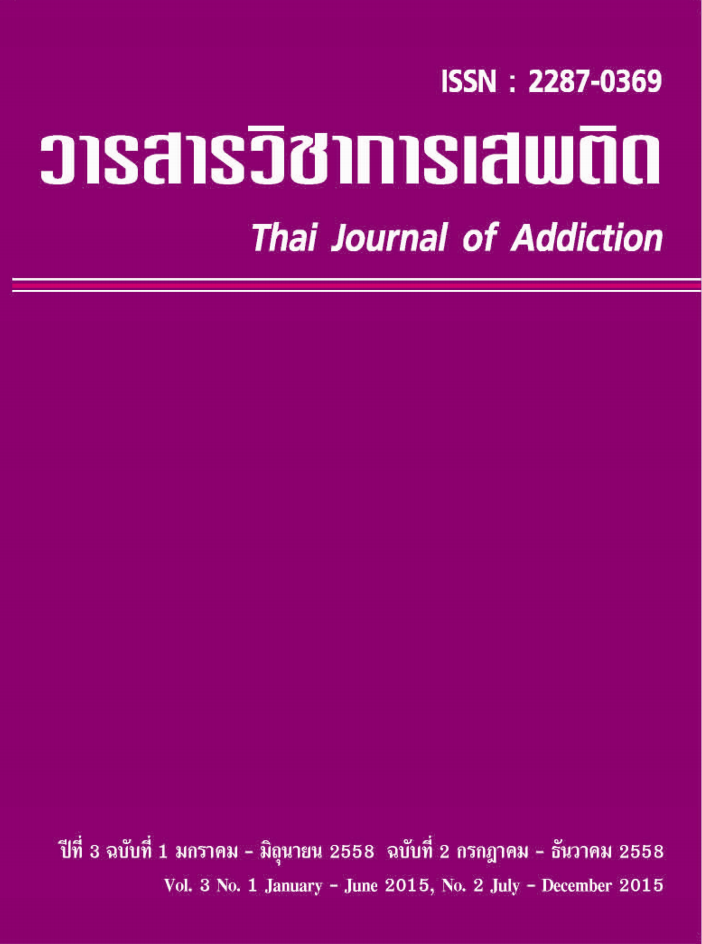The Effectiveness of the Temple Performance as a Centre for the Drug Addicts Rehabilitation
Keywords:
Drug addicts rehabilitation, Promise, Behavior modification, Noble eightfold path.Abstract
This study was an evaluation research. Quantitative research, data collected before. Then bring important issue to analyze in-depth qualitative research method. The purpose of this research was to study : 1) the implementation of temples as a centre for drug addicts rehabilitation. 2) the Lord Buddha teaching about the Noble Eightfold Path as important tool of temple performance to be a centre of drug addicts rehabilitation. 3) the temples achievement of performance as a center of drug addicts rehabilitation. 4) to propose guidelines and new paradigms about how to make temples to be centres of drug addicts rehabilitation.The sampling groups were composed of four temples. These people composed of both Buddhist monks and the commoners which were classified into two categories as; 1) thirty persons as the operational committees of the temples, and 2) one hundred and four drug addicts who were seriously rehabilitated.
Research results found that: 1)The performance of the temples as centres for the drug addicts’rehabilitation was at the “good” level. 2) The monk integrated the noble eightfold path (sila, smadhi, panya) for the drug addicts behavior modification, which their promise and practices get along very well with the sila, smadhi, panya of the Lord Buddha. 3) A comparison between before and after this intensive training for the drug addicts rehabilitation, it was found that: their perceptions about toxic of narcotic drugs were higher; their perceptions about the “noble eightfold path” were higher; their practice behavioral compliance Nobel Eightfold Path Increase over the previous training varies significantly statistical at a confidence level of 0.05, 4) The researcher were found new finding called “PENS Model” as follows :- 1) Promise : promise to be well-behaved persons forever. 2) Eclectic education: integration of intensive training both mundanely and spiritually to stay away from all bad things especially narcotic drugs. 3) Noble eightfold path: highly trained and practiced about panya, sila and samadhi. 4) Social support : strongly supports from three parts of the society network (home, temple and government) were strongly utilized as tools for navigating those drug addicts to return to the right way of their lives, made them to be good practice behaviors, leave the drug abuse, happy and became good citizen of the country.
References
2. กัญญา ภู่ระหงษ์, ผู้เรียบเรียง. คู่มือการดำเนินงานวัดเป็นศูนย์สงเคราะห์และฟื้นฟูผู้ติดยาเสพติด. กรมการแพทย์ กระทรวงสาธารณสุข; 2546.
3. สถาบันธัญญารักษ์. รายชื่อวัดที่ขอขึ้นทะเบียนเป็นสถานพยาบาลตามพระราชบัญญัติยาเสพติดให้โทษ พ.ศ.2552 เอกสารการประชุมวิชาการยาเสพติดแห่งชาติ ครั้งที่ 10. วันที่ 20-22 กรกฎาคม 2552; ณ อิมแพ็ค เมืองทองธานี นนทบุรี. ปทุมธานี : สถาบันธัญญารักษ์; 2552.
4. กรมการศาสนา. พระไตรปิฎกภาษาไทย ฉบับหลวง 2525 พระไตรปิฎก เล่มที่25 พระสุตตันตปิฎก
เล่มที่17 ขุททกนิกาย ขุททกปาฐะ ข้อที่ 6 หน้าที่ 3 (มงคลสูตร).
5. บังอร สำลี. แนวคิดพื้นฐานและหลักการพยาบาล ทฤษฎีการพยาบาล. กรุงเทพมหานคร : องค์การ
สงเคราะห์ทหารผ่านศึก; 2535.
6. ไพศาล ปันแดน. บทบาทของพระสงฆ์ในการพัฒนาชุมชนตามโครงการอบรมประชาชนประจำตำบล
จังหวัดแพร่. [สืบค้น 12 มีนาคม 2550]. เข้าถึงได้จาก http://watkhuhasawan.com/webboard/
index.php.
7. กรมการศาสนา. พระไตรปิฎกพระสุตฺตันฺตปิฏก มัชฺฌิมฺนิกายมูลปัณฺณาสกเล่มที่1 ข้อที่1 หน้า 209, 247-252.
8. วีระชัย ศรีหาผล. การมีส่วนร่วมของพระสงฆ์ในการป้องกันและแก้ไขปัญหายาเสพติดในจังหวัดกาฬสินธุ์.
วิทยานิพนธ์ปริญญาศึกษาศาสตร์มหาบัณฑิต. บัณฑิตวิทยาลัย มหาวิทยาขอนแก่น; 2548.
[สืบค้น 16 พฤษภาคม 2551]. เข้าถึงได้จาก http://web.udru.ac.th/~sutad18/new2/10.html.
9. การประเมินผลกิจกรรมลานวัด ลานใจ ลานกีฬา : กรณีศึกษาวัดที่เข้าร่วมโครงการในจังหวัด
สมุทรปราการพุทธทาสภิกขุ.พุทธประวัติจากพระโอษฐ์ ธรรมทานมูลนิธิ. กรุงเทพมหานคร : พระนคร
การพิมพ์; 2535.
10. พระธรรมกิตติวงศ์ (ทองดี สุรเตโช). พจนานุกรมเพื่อการศึกษาพุทธศาสน์.กรุงเทพมหานคร : ธรรมสภาและสถาบัน
บันลือธรรม; 2551.
11. พระสัทธัมมโชติกะ ธัมมาจริยะ, ปรมัตถโชติกะ ปริจเฉทที่ 1-2-6 จิต เจตสิก รูป นิพพาน. กรุงเทพมหานคร :
ทิพยวิสุทธิ์; 2553.
12. พระธรรมปิฎก (ป.อ.ปยุตฺโต).การศึกษาพัฒนาการหรือบูรณาการ.กรุงเทพมหานคร: มูลนิธิพุทธธรรม;
2543.
13. กรมการศาสนา. พระไตรปิฎกภาษาไทย ฉบับหลวง 2525 พระอภิธัมมปิฏกธัมมสังคณี. เล่มที่34 ข้อที่6
หน้าที่ 28.
14. พระครูศรี. จิตวิทยาแห่งอริยมรรค2550. [สืบค้น 12 มีนาคม 2552].
เข้าถึงได้จาก http://www.watkhuhasawan.com/webboard/index.php.
15. วิสุทธิมัคคปกรณฉบับแปล 2513 ข้อ 3 หน้า198.
16. Stoltz, Pual G.Adversity Quotient Turning Obstacles into Opportunities.
New York : John Wiley & sons. Inc.,Op.cit.; 1997.
17. พระพุทธทาส อินฺทปญฺโญ.บรมธรรมกับการทำงาน.นิตยสารธรรมจักษุ [ระบบออนไลน์].
2535; 76(6) (สืบค้น 11พฤศจิกายน 2556). เข้าถึงได้จาก http://www.dharma-
gateway.com/monk/preach/buddhadas/bdd-33.htm
18. พระธรรมปิฎก (ป.อ. ปยุตฺโต).พุทธธรรม (ฉบับเดิม). พิมพ์ครั้งที่ 16.กรุงเทพมหานคร : บริษัท สหธรรมิก
จำกัด; 2544.



